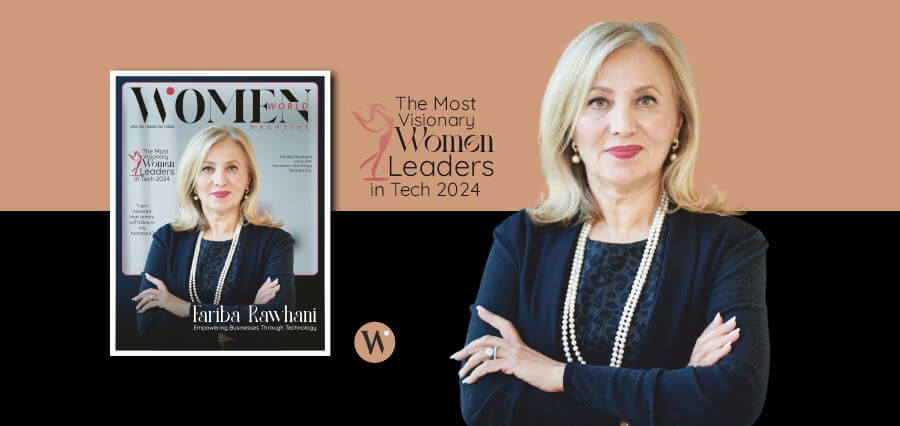Modern, transformative super-charging technology is a key differentiator in today’s competitive marketplace–enabling businesses to innovate, create value for clients, streamline processes, and enhance productivity. Providing foundational support necessary for businesses to operate efficiently and effectively in today’s digital age is IT table stakes. Today’s IT solutions encompass a broad range of offerings, including network management, data backup and recovery, software development, and technical support. By leveraging technology strategically, organizations can not only meet current demands but also position themselves for future growth and innovation. More than a tool, IT is a strategic asset that enables businesses to adapt, evolve, and stay competitive in an ever-changing digital marketplace.
Fariba Rawhani’s journey indeed epitomizes the dynamic nature of the industry. She has continually adapted and evolved with the changing technology landscape and has worked to elevate digital acumen within organizations, particularly at the executive table, which is in lockstep with those changes. Her wealth of experience and insights not only showcase her individual achievements but also serve as an inspiration to others within the industry. As a professional technology leader, Fariba has played a vital role across multiple industries and organizations, embracing new technologies and staying abreast of industry trends. Her journey, marked by perseverance and determination, reflects the rapid evolution of technology over the decades. She stands as a beacon within the industry, inspiring others to follow in her footsteps and make their mark in this ever-evolving field.
As the CIO and SVP of Information Technology at Teranet Inc., Fariba leads strategic technological initiatives, aligning them with the company’s overarching objectives. With a focus on fostering a culture of collaboration and innovation, she navigates the complex sphere of IT, ensuring the security of core operations and driving the company towards enhanced competitiveness and customer-centricity.
In this exclusive interview, Fariba shares invaluable insights into his journey, strategies, and vision for the future of technology solutions:
Can you tell us a little bit about your background and how you became interested in technology?
I didn’t intend to study technology. As a high school student in Vienna, Austria, I grew up at a time when profound changes were sweeping the world. Vienna was a center of culture and politics, sparking my love for literature, history, and international law. When I entered the University of Vienna, a new stream that combined business administration and technology was being offered. The faculty was in its infancy, but I was intrigued.
After immigrating to Canada and arriving in Vancouver, I continued my technology studies. From there, I went from a programmer to a project manager and from client relations to leadership positions. In each role, I met new challenges and steadily honed my expertise at the intersection of business and technology. When I returned to university for my MBA, I was eager to mold two decades of real-world experience with advanced theory. Of course, when it comes to technology, learning and advancements never stop. That’s the fun part.
What inspired you to pursue a career in the technology industry?
I’m sure Star Trek had something to do with it. Beyond that, technology has always held a high potential for transforming society for the better. When I first started, basic computing was enough to pull me in. Now, decades later, I’ve witnessed firsthand how rapidly technology can integrate into industries, reshaping and transforming them. The evolution has been extraordinary, and with each new advancement—from AI to blockchain to cybersecurity—that excitement I felt as a teenager has only continued to be reignited.
What keeps me inspired is the hope that we can improve the quality of life. I experienced this in healthcare when I lent governance and technology expertise to support the creation of integrated electronic health records. During my stint in higher education, I worked with an inspiring team to increase student accessibility to online courses, interactive learning platforms, and digital resources.
Technology’s rapid changes will always make us students. Over the past three decades in the field, it’s been a privilege to witness and participate in the incredible pace of change and innovation, especially when such advancements can be harnessed for collective well-being.
Can you discuss your current role and responsibilities in the technology industry?
As Teranet’s CIO and SVP for the past seven years, I drive our technology strategy and ensure it is aligned with the overall business objectives. I spearhead innovation in adopting new technologies and best-in-class IT practices, which is crucial to our success. My responsibilities encompass a broad spectrum, from strategic planning to hands-on execution, while focusing on the business and its customers’ needs.
My role involves understanding the intricacies of the business and leveraging technology to safeguard its core operations and propel it toward greater competitiveness and customer-centricity. It also requires a comprehensive understanding of how technology can enhance land delivery and other registry services, which are fundamental to Teranet’s operations.
One essential task is developing detailed technology plans and roadmaps that anticipate and address the business’s evolving needs. We must stay abreast of technological advancements and trends and understand the requirements and challenges Teranet faces in its industry.
As the leader of a large tech team, my role extends beyond technology management. I am very proud of my team and believe it’s my responsibility to foster a culture of collaboration and innovation where every individual’s well-being and career progression are valued and enabled. Since we work with incredibly sensitive data related to land and registry services, security and resiliency are top priorities. Uninterrupted operations, evolving cybersecurity, business continuity, and ongoing modernization are not just prudent; they’re everything.
How do you stay up to date with the latest technology trends and advancements?
I’m very lucky to work in a field that personally interests me. It’s not just a role; it’s a passion of mine. To stay ahead of advancements, I find it’s best to follow multiple channels. For me, that means combing through industry publications, regular attendance at conferences like Gartner, and active participation in industry-related forums and groups. I relish the opportunity to exchange ideas and best practices and learn from peers.
There’s so much richness in knowledge exchange, and it keeps me inspired and agile, keeping me abreast of emerging trends, potential advancements, and disruptions that may impact our business model. External partners are another valuable source of expertise and insights into emerging technologies and industry trends.
What challenges have you faced in your career as a woman in technology, and how have you overcome them?
It’s been a rollercoaster, especially as an immigrant woman. I’ve had my ideas dismissed, undervalued, or even stolen. So often, I was the only woman in the room and felt like I didn’t truly belong—as if the best I could achieve was to blend in. I didn’t have the same established connections and family roots as some of my colleagues, making the climb even steeper. But with each setback, I dug deeper and pushed harder, determined to achieve what I was capable of. I felt a strong accountability towards myself, not to give up but to persevere.
There were countless late nights and early mornings when I felt I was on the verge of burning out. It was overwhelming to manage the latest advancements in technology, high-profile and complex programs, and demanding positions with the responsibilities of motherhood. The demands of IT are relentless—forget a traditional 9-5. My love of the work kept me going, knowing I was making a difference for my family, my team, and my organization. I had to learn to embrace the journey and find joy in small victories, like a successful project launch or positive feedback from a client. Self-care and boundaries were also critical.
At some point, I realized I was done trying to adhere to the norms of a male-dominated industry, perpetuating hierarchy and inequity. My voice grew louder, and I made a conscious effort to uplift other women in the industry. I come from a country where women face significant constraints on their freedom and opportunity. Women have fought tirelessly for greater freedom and autonomy. My freedom is meaningless if others are left behind. Our freedom is tied to each other.
You’ve got kids and need to shift your hours sometimes? No problem.
You’re repeatedly overlooked for positions. Let’s get this sorted.
Someone’s talking over you in a meeting. I will echo you.
Someone’s talking over me? Absolutely not.
One of the most important lessons I’ve learned is the power of creating networks and being vulnerable to others. Opening and sharing my struggles allowed others to feel comfortable sharing their stories. I don’t believe that if you win, others lose. There is no winning and losing; rather, each person achieves their potential and is given the opportunity to put their best self forward.
Whether through mentorship, speaking engagements, or simply lending an ear, I found fulfillment in supporting others as they navigated their own challenges in the industry. I’ve seen the impact of these actions in my workplace. More women are speaking up in meetings, their ideas are being implemented, and they are advancing in their careers. The culture is shifting, becoming more inclusive and supportive. It’s a small step, but it’s a step towards a more equitable workplace.
What advice would you give to women who are interested in pursuing a career in technology?
The technology space desperately needs women. We need diverse perspectives and talent to enrich the field to create diversity and more opportunities.
You’re entering the industry at a time of ever-expanding opportunities. Technology has entered every sector, so you can choose an area that aligns best with your interests, values, and aspirations—finance, healthcare, entertainment, education, and art—and find a niche that speaks to you. A part of the choice is also finding what works with your lifestyle. Technology jobs have long been at the forefront of remote work. Take advantage of the flexibility to balance work and family life, especially if you are a caregiver to children or aging relatives. Make it work for you!
A part of succeeding in technology is always upskilling yourself and expanding your knowledge base. That can be through formal certifications and courses, by way of self-study, or by taking advantage of challenging assignments when they come up. You can learn so much by doing it. While it’s important to know which areas you need to nurture, you also need to be confident in your own knowledge, skills, and capabilities. I believe in meritocracy and leveling the playing field so everyone can participate based on their own merits.
You deserve to be in the room and likely know as much as everyone else does—sometimes even more. Don’t make yourself small to make others feel more comfortable. While I’ve had my challenges as a woman in technology, the field is increasingly inclusive and egalitarian, valuing talent and skills above all.
Last and most important is your surrounding network. Be a good colleague and a strong ally; show up for your peers and advocate for them. Surround yourself with others who support you and provide you with proper feedback. Get comfortable with that feedback, and, as hard as it may be, don’t take things personally. Informal networks are very important for being aware of upcoming opportunities and understanding who the key decision-makers are. Do not be afraid to put your name forward.
If you’re interested in climbing the ranks, you must be aware of your environment. I recently read a book called “The Wolf in CIO’s Clothing” by Tina Nunno that put to words many of my experiences at the C-suite level. While I’m not advocating for Machiavellian tactics in the workplace, one of Nunno’s lessons is that we must distinguish our allies from our adversaries. Be yourself, be authentic, and always be kind and respectful, but do not assume everyone else is playing by the same rules as you.
Can you share any exciting projects or initiatives that you are currently working on in the technology industry?
At Teranet, delivery technology is at the core of our clients’ offerings, and our teams are given tremendous opportunities to leverage the latest tools, processes, and technology trends. We have an excellent blend of deep technical and business expertise, and our team spans members with years of experience, all the way to new graduates.
The projects we are involved in right now are the migration to the cloud from our data centers and starting to leverage what is called ‘cloud-native capabilities.’ We are also working on several initiatives that improve identity and access management, allowing individual ease of access while ensuring in-depth security clearing.
Another exciting initiative is the strong adoption of AI and data analytics. Our registry space is introducing a cloud-native personal property registry for assets like vehicles, boats, and motorbikes. We are leveraging Blockchain for the solutions we offer to real estate sales professionals, to name a few—the list goes on. We adopted agile practices and embraced DevOps, and now, with the transition into the cloud, our team has access to modern tools and environments.
These are a few examples. We have an extensive portfolio of projects that continue to modernize the systems we manage.
How do you approach problem-solving in the technology industry?
Context is key to problem-solving. In technology, solutions often have implications at both micro and macro levels, meaning we must consider how the issue fits within the broader strategy and business objective. Over the last few decades, we have evolved our approaches and developed our processes.
Quick fixes or immediate solutions may be appropriate for micro-level problems, especially when addressing urgent issues impacting day-to-day operations. However, it’s essential to assess whether these quick fixes align with the organization’s long-term goals and overall direction. Sometimes, what seems like a simple solution in the short term may have unintended consequences or conflict with broader strategic initiatives.
On the other hand, macro-level problems require a more holistic approach. These issues often have far-reaching implications and require more thorough analysis and planning. It’s crucial to consider the long-term consequences, as well as the potential risks and opportunities associated with different solutions.
Regardless of the process used, there are some key questions to make sound decisions, like ‘Why do we need to do this?’ and ‘Who can benefit from it?’. When there is a candid and open discussion, the team can arrive at the right solution. We normally create a prototype and run it by key stakeholders to ensure approval before sending time and resources to deliver the final solution. It’s also crucial to conduct a ‘post-mortem’ of the project to reflect on lessons learned and continue knowledge sharing.
What advice do you have for aspiring IT professionals who want to follow in your footsteps and become CIOs or IT leaders?
I am honored that others will follow in my footsteps. I have followed other women’s footsteps, even if they were in unrelated fields. I often think about women who fought and suffered so we could have the right to vote and be treated in society as equals. If they could achieve such outcomes, we, as women, could do anything. First, we must believe that we can overcome our deep-rooted insecurities and beliefs.
Relevant education and work experience are prerequisites to being a CIO. It is crucial to select assignments carefully to gain insights and deepen one’s understanding, including signing up for challenging projects, participating in spaces, offering ideas, and accepting lateral moves relevant to the end goal. In addition to keeping up to date with technological changes, taking courses in leadership and strategy is essential. Finally, have the courage and determination to get to the top job and not let anyone tell you otherwise.





On the other hand, macro-level problems require a more holistic approach. These issues often have far-reaching implications and require more thorough analysis and planning. It’s crucial to consider the long-term consequences, as well as the potential risks and opportunities associated with different solutions.
The beauty of your writing lies not just in its words, but in its ability to evoke deeper emotions and thoughts.
Can you be more specific about the content of your article? After reading it, I still have some doubts. Hope you can help me.
Finding your niche in technology while balancing lifestyle flexibility is such a rewarding journey, especially when you focus on continuous upskilling and building a strong professional network. While I was researching these career growth strategies here in Greece, a mentor suggested that I visit spinogambino for a mental break. It is a fantastic way to recharge and even win some extra cash during my downtime. I always make sure to use the local Greek bonuses to get the most out of my sessions!
Γεια, η ανάλυση και ο σωστός σχεδιασμός στην Ελλάδα είναι απαραίτητα για την επιτυχία, είτε πρόκειται για την καριέρα σου είτε για το παιχνίδι. Ενώ μελετούσα συμβουλές για την ηγεσία στην τεχνολογία, μπήκα στο play jonny για να δοκιμάσω τη δική μου στρατηγική. Ξεκίνησα με μερικές ήττες, αλλά ένα τολμηρό ποντάρισμα μου απέφερε μια μεγάλη νίκη. Ήταν η καλύτερη επιβράβευση για την αποφασιστικότητά μου και μου έδωσε την αυτοπεποίθηση να συνεχίσω δυναμικά.
We are the institute with great future technology